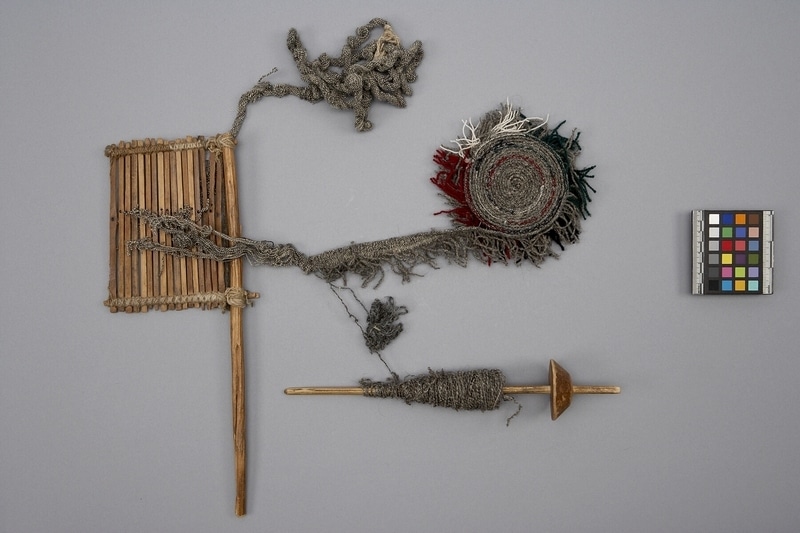Fringe Loom Item Number: Sf1009 from the MOA: University of British Columbia


Description
A loom with an incomplete textile; the shedding device is a number of narrow sticks with one hole in the centre of each which are lashed together leaving narrow spaces. This is lashed to a longer round stick. The unwoven warps are threaded through the holes and the spaces between sticks. 241 cm of unwoven warp twist together on one side of the shedding device. On the other side is 33 cm of unwoven warp and 304 cm of woven band with fringe like loops extending from one side. The band is speckled grey and the fringes alternate areas of grey with short areas of red, blue, white and green. At the junction of the woven band and unwoven warp, two weft of cross threads are attached to the textile. One is a small grey finger skein and the other is also grey but is wound on the shaft of a wooden spindle with a cone shaped whorl.
History Of Use
The fringe loom is likely a variation on a European rigid heddle loom as there are no archaeological looms of this type in Peru. In Taquile, fringed bands are used on marriage ponchos, as well as, on a variety of red patterned cloths that are worn on the shoulders and hips for dancing at some fiestas. The bands are sewn around the entire perimeter of the garments. The colours in the fringe band are the same as the stripes in marriage ponchos.
Cultural Context
weaving
Specific Techniques
Grey warp and weft yarns are hand spun, undyed sheep's wool, z spun and plied 2-s. White, green, red and blue yarns are synthetic commercial yarns, also z spun and plied 2-s. The band is warp-faced plain weave woven with a ground weft in the conventional way. The fringe weft is doubled in every shed and the loop that extends from the shed re-plies z with itself. The shed maker is a hole and slot or rigid heddle which produces 2 sheds.
Narrative
Bought from Juan Cruz Quispe who prepared the warp and wove the band. The warp yarns were prepared in the house of his daughter, Candelaria Cruz Machaca. The loom was obtained from the house of his grandson, Rosendo Quispe Cruz. Ownership unknown. Juan demonstrated weaving on the loom and photographs were taken. The warps are stretched between the seated wearer and a peg in the ground. Sheds are changed by propping the heddle on its handle or letting it hang free. The spindle is twirled occasionally so the fringe weft will double on itself.
Item History
- Made by Juan Cruz Quispe (Maker) in Taquile, Puno, Peru during October 1987
- Collected by Mary Frame during 1987
- Owned by Mary Frame before November 3, 1987
- Received from Mary Frame (Seller) and Museum of Anthropology Shop Volunteers (Funding source) on November 3, 1987
What
Who
- Culture
- Quechua
- Creator
- Juan Cruz Quispe (Maker)
- Field Collector
- Mary Frame
- Previous Owner
- Mary Frame
- Received from
- Mary Frame (Seller) and Museum of Anthropology Shop Volunteers (Funding source)
Where
- Holding Institution
- MOA: University of British Columbia
- Made in
- Taquile, Puno, Peru
When
- Creation Date
- during October 1987
- Collection Date
- during 1987
- Ownership Date
- before November 3, 1987
- Acquisition Date
- on November 3, 1987
Other
- Item Classes
- textiles
- Condition
- good
- Accession Number
- 1274/0037